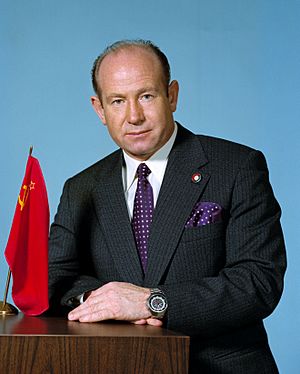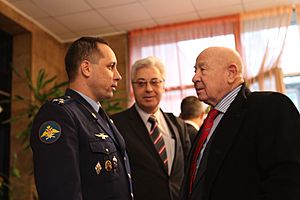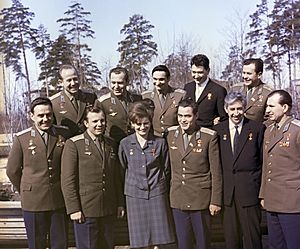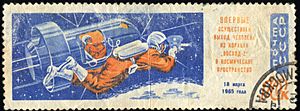Alexei Leonov facts for kids
Quick facts for kids
Alexei Leonov
|
|
|---|---|

Alexei Leonov in April 1974
|
|
| Born |
Alexei Arkhipovich Leonov
30 May 1934 Listvyanka, West Siberian Krai, Russian SFSR, Soviet Union
|
| Died | 11 October 2019 (aged 85) Moscow, Russia
|
| Nationality | Russian |
| Occupation | Fighter pilot, Cosmonaut |
| Awards | Hero of the Soviet Union (twice) |
| Space career | |
| Soviet cosmonaut | |
| Rank | Major General, Soviet Air Force |
|
Time in space
|
7d 00h 32 m |
| Selection | Air Force Group 1 |
|
Total EVAs
|
1 |
|
Total EVA time
|
12 minutes, 9 seconds |
| Missions | Voskhod 2, Soyuz 19 (ASTP) |
|
Mission insignia
|
|
Alexei Arkhipovich Leonov (born May 30, 1934 – died October 11, 2019) was a famous Soviet and Russian cosmonaut. He was also an Air Force Major general, a writer, and an artist.
On March 18, 1965, Alexei Leonov made history. He became the first human to walk in space. This amazing spacewalk happened during the Voskhod 2 mission. He spent 12 minutes outside his spacecraft.
Later, in July 1975, Leonov commanded the Soviet Soyuz spacecraft. This was part of the Soyuz-Apollo mission. It was a very special event. A Soviet and an American spacecraft docked together in space for two days.
Contents
Early Life and Education
Alexei Leonov was born in Listvyanka, a place in what was then the Russian SFSR. This was part of the Soviet Union. When he was young, his family faced tough times. His father was arrested during a period when many people were unfairly targeted by the government.
In 1948, his family moved to Kaliningrad. Leonov later studied to become a pilot. In 1957, he graduated from the Chuguev military pilots' academy. This academy was in the Ukrainian Soviet Socialist Republic.
Soviet Space Program
In 1960, Alexei Leonov was chosen to be one of the first 20 Soviet Air Force pilots to train as a cosmonaut. He was a member of the Communist Party of the Soviet Union.
His famous walk in space was originally planned for an earlier mission. But it finally happened on the Voskhod 2 flight. On March 18, 1965, he spent 12 minutes and nine seconds outside the spacecraft. He was connected to the craft by a 4.8 meter (about 16 feet) tether.
At the end of his spacewalk, Leonov faced a big problem. His spacesuit had puffed up a lot in the vacuum of space. This made it very hard for him to get back into the airlock. He had to open a valve to let some air out of his suit. He barely managed to squeeze back inside the capsule. Leonov had trained for 18 months to prepare for this mission. He practiced being in weightlessness.
After his first mission, Leonov was chosen for other important flights. In 1968, he was supposed to command a flight around the Moon. This mission was cancelled because of delays. Also, the American Apollo 8 mission had already flown around the Moon. He was also chosen to be the first Soviet person to land on the Moon. But this project was also cancelled.
Leonov was supposed to command the 1971 Soyuz 11 mission. This mission was going to the first crewed space station, Salyut 1. However, his crew was replaced at the last minute. One of the members was thought to be sick.
Leonov's second trip into space was also very important. He commanded the Soviet part of the 1975 Apollo-Soyuz mission. This mission, called Soyuz 19, was the first time the Soviet Union and the United States worked together in space.
From 1976 to 1982, Leonov was the leader of the cosmonaut team. He was also a deputy director at the Yuri Gagarin Cosmonaut Training Center. There, he helped train new cosmonauts. He retired in 1992.
Later Life and Death
Alexei Leonov was a very talented artist. He published books that showed his artwork. He also worked with his friend Andrei Sokolov on art projects. Leonov even took colored pencils and paper into space. From space, he sketched the Earth. He also drew pictures of the Apollo astronauts who flew with him during the Apollo–Soyuz Test Project.
The famous writer Arthur C. Clarke mentioned Leonov's art. After watching the movie 2001: A Space Odyssey, Leonov pointed out something interesting. The way the Moon, Earth, and Sun lined up in the movie was similar to his 1967 painting, Near the Moon.
In 2004, Leonov and former American astronaut David Scott wrote a book together. It was about the Space Race between the United States and the Soviet Union. The book was called Two Sides of the Moon: Our Story of the Cold War Space Race. Famous people like Neil Armstrong and Tom Hanks wrote introductions for the book.
Leonov also contributed to the 2007 book Into That Silent Sea. This book described his life and career in space exploration.
Alexei Leonov passed away on October 11, 2019, after a long illness. He was 85 years old. He was the last surviving cosmonaut from the Voskhod programme.
Legacy

- A crater on the far side of the Moon was named the Leonov crater in 1970. It is near the Sea of Moscow (Mare Moscoviense).
- Arthur C. Clarke's 1982 novel 2010: Odyssey Two was dedicated to Leonov and Andrei Sakharov. The fictional spaceship in the book, the Cosmonaut Alexei Leonov, was named after him.
- Leonov, along with Rusty Schweickart, Vitaly Sevastyanov, and Georgy Grechko, started the Association of Space Explorers in 1984. This group is for all people who have flown in outer space.
- In the Star Trek novel Destiny: Gods of Night, there is a ship named the U.S.S. Alexei Leonov.
- Leonov appears as a character in a 2013 Doctor Who comic book story called "Space Oddity".
- The film The Age of Pioneers (2017) is based on Leonov's story about the Voskhod-2 mission. Yevgeny Mironov played Leonov in the movie.
- The song "E.V.A" by Public Service Broadcasting talks about Leonov's first spacewalk. It is on their 2015 album The Race for Space.
Images for kids
-
Leonov receiving the Order "For Merit to the Fatherland", 3rd class, from Vladimir Putin in 2014.
-
Leonov in 2016, wearing his two Hero of the Soviet Union medals.
-
Leonov, Stephen Hawking, and Brian May at the Starmus Festival, 2016.
-
The historic handshake between Leonov and Tom Stafford.
-
Leonov (left) with Deke Slayton in the Soyuz spacecraft.
See also
 In Spanish: Alekséi Leónov para niños
In Spanish: Alekséi Leónov para niños











